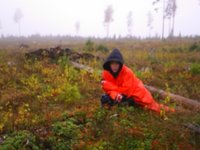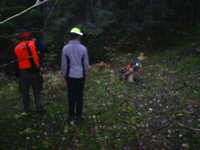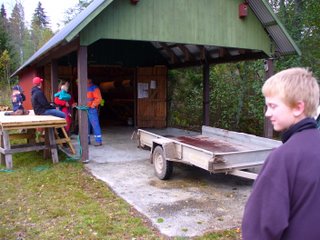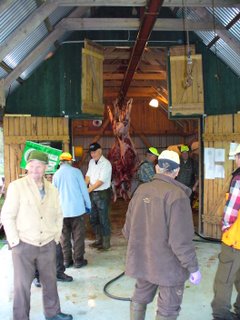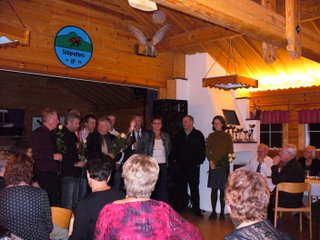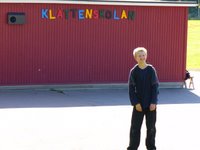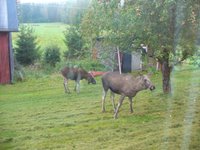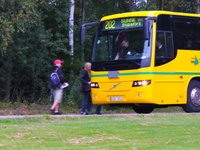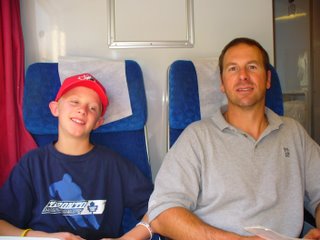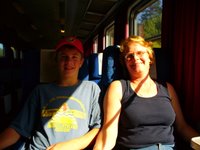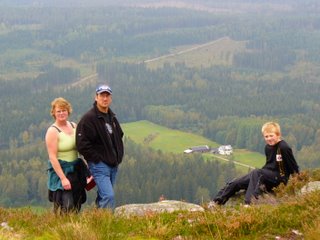 The last post was about hunting, so I guess it makes sense that the next should be about gathering. September was a month of beautiful sunshine and warmth. We spent much of our free time hiking through the wood in search of mushrooms and berries. These activities continued into October, but the outings became infrequent: the cold and rainy weather and the moose hunt put a damper on our forays into the woods (skogen).
The last post was about hunting, so I guess it makes sense that the next should be about gathering. September was a month of beautiful sunshine and warmth. We spent much of our free time hiking through the wood in search of mushrooms and berries. These activities continued into October, but the outings became infrequent: the cold and rainy weather and the moose hunt put a damper on our forays into the woods (skogen).Our first weekend in Sweden, we drove up to the top of the local mountain, Tosseberg, to check out the view. That is our white house between D and K and I in the picture. Because tourist season had passed, none of the buildings at the top were open, so we couldn't climb the tower. But we wandered around and had a look and searched for the launching spot the hang gliders we had seen earlier must have used. We eventually found that and the path that looked like it must head down our side of the mountain.
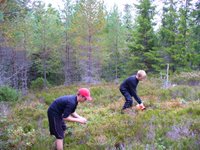
While K drove down and went to help J and Farfar (literally father's father) with the porch they were building, the boys and I hiked down. What normally takes about 25 minutes, took us over an hour as we stopped time and again to gather blue berries and lingon berries we couldn't pass by. They were literally everywhere: on the sparsely treed, rocky, lichen covered mountain top, and all the way down through the dense forest with its open understorey and knee-deep moss. We came back with a liter or so of berries, despite all we ate as we picked. That was our introduction to berry picking.
Once Hol and the kids returned from Canada, we met Farfar and Farmor (you guessed it - father's mother) at their stuga (cabin) and went for a wonderful fall hike up another mountain. As we hiked up, J's parents pointed out all the important things to see, including which were the edible mushrooms. Once at the top, we checked out a confidence course that had been set up
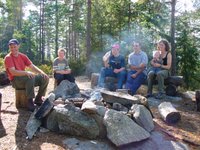 and climbed the tower to take in a wonderful view. While at the summit we had a picnic which included smörgas (open faced sandwiches) and korv (hotdogs) roasted on a fire which we ate on the cute little half-size hotdog buns they have here. Toppings included ketchup, mustard and something called americansk sås which tastes like a combination of cheeze whiz, ketchup, mayo and relish. Apple cake followed and all was washed down with either water or milk. Quite a feast! When it was time to head down the grandparents took E back to the cars with them. They would drive back to the stuga, and we would walk back heading down the other side of the mountain.
and climbed the tower to take in a wonderful view. While at the summit we had a picnic which included smörgas (open faced sandwiches) and korv (hotdogs) roasted on a fire which we ate on the cute little half-size hotdog buns they have here. Toppings included ketchup, mustard and something called americansk sås which tastes like a combination of cheeze whiz, ketchup, mayo and relish. Apple cake followed and all was washed down with either water or milk. Quite a feast! When it was time to head down the grandparents took E back to the cars with them. They would drive back to the stuga, and we would walk back heading down the other side of the mountain.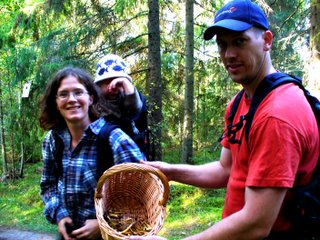
Again, we gathered berries, although we were really only finding blueberries in the higher spots by then. The lingons were still everywhere, so we picked many of these. What was memorable about this trip was the introduction to mushrooming for the whole family. K has never been a big fan of picking berries - it just slows you down when hiking. Mushroom picking is different. Finding kantarells - the golden mushrooms you can eat - is like finding gold. You look and look and feel very lucky when you find any. If you find a whole bunch together in a fairy ring, it's like hitting the jackpot. The walk down the mountain and through the woods to the stuga was a giant mushroom hunt where we fanned out and hiked through the moss, lichen, trees, bushes, rocks and bog in search of svamp (mushrooms). It wasn't long before we stopped calling to Hol or J to see if we had the right kind or not. Even the boys were hooked! D became a quick expert finding many kanterells and also some blek tagsvamp which are the two kinds that we are able to recognize reliably.
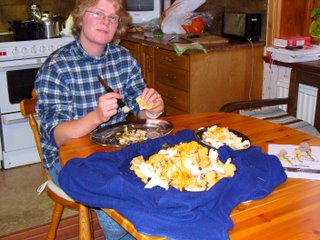
While the weather remained agreeable and sometimes even when it wasn't, we spent many afternoons wandering through the woods close to home in search of berries or mushrooms to pick. This has been a great way to get to know this area where we are living.
